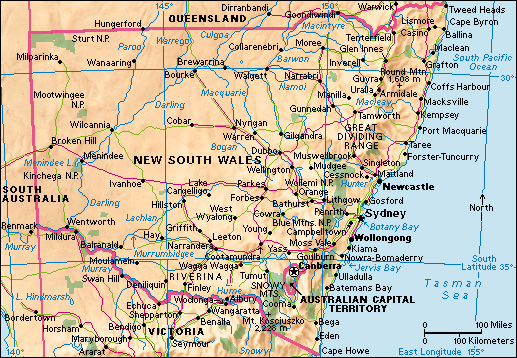Parkes (pop. 9,832) is a town in central New South Wales, Australia. It is about 230 miles (370 kilometers) west of Sydney. The town of Parkes includes the townships of Bogan Gate, Peak Hill, Trundle, and Tullamore—smaller communities with their own distinct histories. Parkes is perhaps best known as the site of the Parkes radio telescope, which has helped astronomers make notable advances in their investigation of the universe.

The Parkes radio telescope is part of the Parkes Observatory, which is operated by the Commonwealth Scientific and Industrial Research Organisation (CSIRO). The telescope, which has a diameter of 210 feet (64 meters), began operating in 1961. In 1962, astronomers used the telescope to pinpoint the first of the distant, mysterious groups of stars called quasars. In 1969, the telescope helped United States mission controllers at the National Aeronautics and Space Administration (NASA) track the progress of the Apollo 11 spacecraft on its voyage to the moon. The Australian motion picture The Dish (2000) tells the story of Parkes’s residents and their involvement with the moon landing. The telescope was also involved in the approach of the European Space Agency’s Giotto spacecraft to Halley’s Comet in 1986.
Parkes is also known internationally for its annual Elvis Festival. The festival was first held on Jan. 8, 1993, as a local event to celebrate the birthday of the American rock star Elvis Presley. Since then, it has grown into a multiday celebration that attracts Elvis fans and impersonators from all over the world.
Parkes is a national transportation hub. It lies at the junction of two major railway lines. Its chief agricultural products are grain and other cereal crops, and hay and wool. In addition, many townspeople work in the health care, mining, and retail industries.
The area’s traditional inhabitants are the Wiradjuri people, one of the largest Aboriginal groups in New South Wales. Europeans first claimed the Parkes area in the early 1800’s, as pastoralists (livestock farmers) traveled to the region to raise sheep. Early European settlers called the community there Bushmans, or Bushman’s Town.
Bushmans and several nearby communities became part of a gold rush in the late 1800’s. As a result, the region experienced an economic transformation. Gold was discovered in Forbes and Currajong. Prospectors also found gold and lead reserves in the general area of Bushmans. After experiencing significant population growth, Bushmans was officially surveyed in 1873. That same year, it was renamed in honor of Sir Henry Parkes, a long-serving premier of New South Wales. Parkes was declared a town in 1885.
The Parkes railway station opened in 1893. It became a transportation hub for the region. During the early 1900’s, the town was also connected to a major road later known as the Newell Highway. The Parkes section of the Newell Highway has experienced many floods. One of the worst local floods on record occurred in November 2022, after significant rainfall caused the Lachlan River to overflow onto the highway and into nearby communities.
